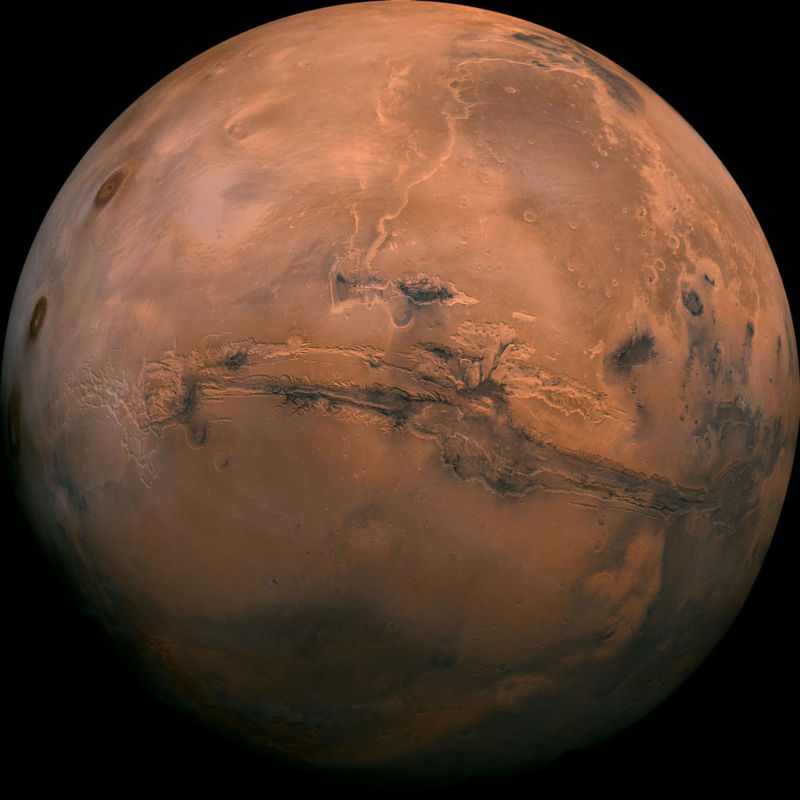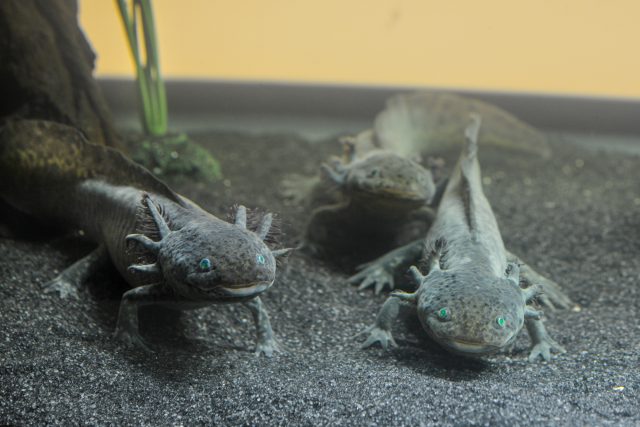
As philosopher-mathematician Jeff Goldblum once said, “life, uh, finds a way.”
To phrase that more scientifically, evolution has had billions of years of trial and error to produce species that are well adapted chemically and physically. Many human researchers want to imitate that adaptation, turning lessons from the natural world into practice in engineering, technology, and architecture. The entire venture goes under the name “biomimicry.”
“I think biomimicry is really beautiful,” says Ariel Ekblaw, a student at MIT’s Media Lab, who founded and leads the Media Lab’s Space Exploration Initiative. “It’s both a framework and... a set of tools or learnings from nature that can inform modern engineering and science research projects.”
To see the spectrum of biomimicry research, I attended a three-day workshop called “Nature-Inspired Exploration for Aerospace.” The workshop was cosponsored by NASA’s Glenn Research Center, the Ohio Aerospace Institute, and Great Lakes Biomimicry. Despite the aerospace focus, the program ranged from straight-up biology to philosophical queries about the reasons for doing biomimicry in the first place.
Sticking to nature for innovation
The classic example of biomimicry is Velcro®. In 1941, Swiss engineer George de Mestral drew inspiration from burrs sticking to his dog’s fur to create the now-familiar fastening system based on tiny hooks and loops.
But Velcro® seems primitive compared with modern biomimicry projects. Researchers look at whale flippers to improve wind-turbine designs, common reeds (Phragmites australis) to muffle sounds from airports, and sidewinding snakes to build robots that can climb difficult slopes. Others study organisms living in extreme environments—high-elevation deserts, deep-sea volcanic vents, Antarctica—to help understand how humans might live in resource-scarce places, whether on Earth, the Moon, or Mars.
The core goal of the NASA biomimicry workshop was drawing together people from many disciplines in hopes of fostering collaborations with NASA for the future of aerospace technology. Many NASA researchers are interested in biomimicry because it promises pure efficiency, a must given the high cost of transporting materials into space. But there’s also the prospect of eliminating the need to transport things entirely. Organisms build themselves from the available raw materials of their environment, in the form of food (however defined) and environmental sources of water.
For instance, if a Mars habitat could be built—or assemble itself from modular components—using materials obtained on Mars itself, it would potentially save a vast amount of mass during launch from Earth. That, in turn, translates into fuel savings, possibly allowing for the spacecraft to carry other important cargo.

Green concepts
“Biomimicry itself is not exactly a new concept; it’s actually quite old,” says Teresa McNulty, who studies at the Biomimicry Center of Arizona State University. “[Ancient civilizations] would record what they observe in nature and then use that in some ways to inform better designs and new technologies.”
Modern biomimicry research takes these old ideas and applies them in systematic ways. The field is intrinsically interdisciplinary, bringing in biologists, roboticists, materials scientists, and engineers of all flavors. Talking with biomimicry researchers, it’s not unusual to find people with multiple degrees in seemingly unrelated fields—like engineers who now study moth wings or do fieldwork in South America.
McNulty, for instance, worked in metallurgy and materials science previously. Her interest in biomimicry largely flows from a strong interest in sustainability.
“Nature elegantly uses a small subset of materials on the periodic table of elements and actually is able to manufacture materials with ambient temperatures,” she says.
In other words, without the ability to drastically alter the temperature or chemistry of their environment the way humans do, organisms grow, consume, and reproduce using the resources and conditions they have available. By contrast, human manufacturing in industrialized nations often relies on high temperatures, inefficient water usage, and materials that are difficult to extract or recycle (such as the rare earth elements essential to electronics). Yet without the ability to drastically alter the temperature or chemistry of their environment the way humans do, organisms grow, consume, and reproduce using the resources they have available.
That doesn’t necessarily mean “nature” (loosely defined) has the best or most efficient ways of doing things or that biomimicry is the only way to improve things like resource extraction and engineering. Rather, we can analyze the known successes of evolution and use them as a model for improving current practice. It’s a theme that came through again and again during the Nature-Inspired Exploration for Aerospace workshop.
“One thing that I’m really attracted to about biomimicry is that sustainability is kind of built-in at the core,” says McNulty. That includes eliminating or minimizing non-recyclable waste. After all, very few waste products of organisms aren’t usable by some other organism. “I really hope that by leveraging biomimicry on a system level, you can also get a more sustainable system of materials from cradle-to-grave, in which case ‘grave’ doesn’t really exist anymore.”

Extreme life, extreme engineering
Efficiency of resource use is more than a green design choice for space exploration: it’s an absolute necessity. Any material that can’t be recycled or repurposed is a waste of space and mass; wasted resources or hazardous end-products could be dangerous or fatal to astronauts. Potential crewed Mars missions are on many biomimicry researchers’ minds for that reason.
Even a short-duration Mars trip is measured in months. The longer the stay, the harder the problems of living there become.
To think about those problems, biomimicry researchers look to “extremophiles,” organisms that live in the harshest conditions on Earth (by human standards, at least). Mars is a simultaneously cold, dry, chemically hostile, and high-radiation environment. As a result, many space-oriented biomimicry researchers look at how desert plants extract and purify water for their use, how fungi thrive in high-radiation environments, how proteins enable insects to fold large structures like wings inside small pupae during metamorphosis, and so much more. In the words of Terry Pratchett, “life lives everywhere that life can. Where life can’t, this takes a little longer.”
Claudia Rivera of the National Autonomous University of Mexico spoke at the conference about the “genius of place,” or how organisms adapt to the specific conditions in a location. Her example was the Atacama Desert of Chile, which is a rich and complicated ecosystem despite being at very high elevation and the driest desert outside of Antarctica. (The Atacama may not have received any measurable rainfall between 1570 and 1971; even today, accumulated rainfall is measured in millimeters.) Scientists estimate the desert may have been arid for 3 million years or more, meaning life has had plenty of time to adapt to its conditions.
Rivera cited llareta, an Atacama plant that tolerates extreme lack of moisture, high winds (both hot and cold), and intense sunshine. From the outside, llareta looks much like a mossy boulder or a flat mat of moss; inside, it’s a dense tangle of branches. This structure minimizes wind drag, but it also locks moisture in and limits evaporation. Llareta also produces resins to help the plant resist freezing.
Since the Atacama’s soils are full of salt and alkaline chemicals, the available water is toxic to many organisms (including humans). Additionally, that water is often in the form of a relatively small number of molecules clinging to soil particles, rather than the more saturated soils of wetter places. Desert plants extract salts from the soil and excrete them on their leaves, or they filter out chemicals that would be otherwise toxic to them.
Yet the plants still extract enough to live on. To put it another way: when water is scarce, organisms can’t afford metaphorically to turn their noses up at stuff that’s hard to get or tastes bad.
As a number of robotic probes have shown, subsurface water on Mars is plentiful, especially at high latitudes. However, it’s generally frozen and mixed with perchlorate salts, sulfates, and other chemicals nasty to human explorers—much as the water in the Atacama Desert is toxic and difficult to obtain.
Whether drinking it, using it to grow food, or processing it into a component of fuel to return to Earth (a distinct possibility, since transporting enough extra fuel to get home will be very expensive), it’s obvious humans will need to use Martian water, no matter how toxic it is.
Other extreme organisms could also help show the way. Many species of bacteria have membranes that permit water but reject toxic chemicals. Plants like the sacred lotus have water-impermeable leaves, which allow them to separate water from dirt using gravity alone. As Andrew Trunek of NASA said in his conference talk, everything astronauts on Mars need to do to get water, organisms have evolved to do without using a nuclear power plant. If we can learn to do the same, humans will have a much easier time on the Red Planet.
Self-assembling space stations
MIT’s Ekblaw identifies two major approaches to biomimicry research: problem-driven, which often attracts the engineers, and curiosity-driven, which is a draw for the pure scientists.
“I’m primarily problem-driven in that I’m an aerospace structures researcher looking at a scalable, low-energy, efficient way to assemble architecture in zero-gravity environments,” she says. “The current model of the International Space Station is very complicated, very energy expensive, [and] very risky in terms of human life to assemble. How can we look to nature for a pattern of self-assembly—an elegant, simpler, efficient way to bring pieces together?”
Ekblaw envisions a space station module that assembles like a three-dimensional puzzle. The instructions for assembly are all encoded as part of the puzzle pieces, rather than requiring robotic or human intervention to put the module together. Organisms do this self-assembly trick on multiple levels: proteins form networks; colonial amoebas group together into a slug-like aggregate that crawls; ants collectively make a bridge across gaps. The assembly doesn’t need intelligence—just simple chemical or electric communication among its components.
Engineering self-assembly in which the dimensions are measured in centimeters or meters is more challenging. That’s because there are potentially many more possible configurations for the pieces to come together. (As Ekblaw points out, if the most desirable configuration from an energy point of view is the pieces lying in opposite corners, you’ve got a problem.)
“How can you embed elements of that final logic into each individual unit so that they come together in an efficient way?” Ekblaw says. “The way I do that in my system is through magnets, the geometry of the beveling, [and] a few other proposals.” The latter includes “biasing,” or using an air blower or some other mechanism to help guide the pieces toward each other.
reader comments
72